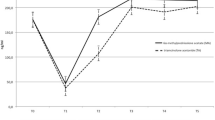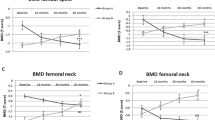Abstract
Background: To investigate the hypothalamic-pituitary-adrenal (HPA) axis in patients with ankylosing spondylitis (AS) and healthy controls. Methods: Forty-nine AS patients and 20 healthy controls were included. Low-dose ACTH test (LDST) was used to assess the HPA axis. Basal cortisol, stimulated peak cortisol levels, and acutephase reactants [C-reactive protein (CRP), erythrocyte sedimentation rate, and fibrinogen] were studied. Bath Ankylosing Spondylitis Functional Index, Bath Ankylosing Spondylitis Disease Activity Index (BASDAI), and Bath Ankylosing Spondylitis Metrology Index were also evaluated. Results: Patient and control groups were not different regarding age, sex, body mass index and waist circumference (WC). Basal cortisol levels did not show a significant difference between groups. However, cortisol increment after low-dose ACTH was significantly impaired in AS subjects with respect to controls (20.0±4.4 vs 24±2.2 μg/dl, p<0.001). Eleven AS patients had impaired cortisol peak after LDST when a cortisol cut-off is accepted as 500 nmol/l (18 μg/dl) and none of the controls exhibited a peak cortisol responses to LDST<500 nmol/l. Comparison of AS subjects who were receiving anti-tumor necrosis factor (TNF) (no.=23), and conventional therapy (no.=26) yielded similar basal and peak cortisol concentrations. Peak cortisol cocentrations were associated with basal cortisol, impaired cortisol response, CRP, and fibrinogen. Impaired cortisol response (subjects with peak cortisol levels <18 μg/dl) was significantly correlated with basal and peak cortisol concentrations and BASDAI. Conclusion: Our results indicate an increased prevalence of subclinical glucocorticoid deficiency in AS patients. Anti-TNF treatment seems not to have effect on HPA axis.
Similar content being viewed by others
References
Akkoc N, Khan MA. Epidemiology of Ankylosing Spondylitis and Related Spondyloarthropathies. In: Weisman MH, Reveille JD, van der Heijde D, eds. Ankylosing Spondylitis and the Spondyloarthropathies. St. Louis: Mosby. 2006, 117–31.
Braun J, Sieper J. Ankylosing spondylitis. Lancet 2007, 369: 1379–90.
Penesova A, Rovensky J, Zlnay M, et al. Attenuated insulin response and normal insulin sensitivity in lean patients with ankylosing spondylitis. Int J Clin Pharmacol Res 2005, 25: 107–14.
Sari I, Demir T, Kozaci LD, et al. Body composition, insulin, and leptin levels in patients with ankylosing spondylitis. Clin Rheumatol 2007, 26: 1427–32.
Toussirot E, Streit G, Nguyen NU, et al. Adipose tissue, serum adipokines, and ghrelin in patients with ankylosing spondylitis. Metabolism 2007, 56: 1383–9.
Gooren LJ, Giltay EJ, van Schaardenburg D, Dijkmans BA. Gonadal and adrenal sex steroids in ankylosing spondylitis. Rheum Dis Clin North Am 2000, 26: 969–87.
Kurtais Y, Tur BS, Elhan AH, Erdogan MF, Yalcin P. Hypothalamic-pituitary-adrenal hormonal responses to exercise stress test in patients with rheumatoid arthritis compared to healthy controls. J Rheumatol 2006, 33: 1530–7.
Straub RH, Pongratz G, Cutolo M, et al. Increased Cortisol relative to adrenocorticotropic hormone predicts improvement during anti-tumor necrosis factor therapy in rheumatoid arthritis. Arthritis Rheum 2008, 58: 976–84.
Tzioufas AG, Tsonis J, Moutsopoulos HM. Neuroendocrine dysfunction in Sjogren’s syndrome. Neuroimmunomodulation 2008, 15: 37–45.
Sulli A, Montecucco CM, Caporali R, et al. Glucocorticoid effects on adrenal steroids and cytokine responsiveness in polymyalgia rheumatica and elderly onset rheumatoid arthritis. Ann N Y Acad Sci 2006, 1069: 307–14.
Imrich R, Rovensky J, Zlnay M, et al. Hypothalamic-pituitary-adrenal axis function in ankylosing spondylitis. Ann Rheum Dis 2004, 63: 671–4.
Kirnap M, Atmaca H, Tanriverdi F, Ozsoy O, Unluhizarci K, Kelestimur F. Hypothalamic-pituitary-adrenal axis in patients with ankylosing spondylitis. Hormones (Athens) 2008, 7: 255–8.
van der Linden S, Valkenburg HA, Cats A. Evaluation of diagnostic criteria for ankylosing spondylitis. A proposal for modification of the New York criteria. Arthritis Rheum 1984, 27: 361–8.
Lindholm J, Kehlet H, Blichert-Toft M, Dinesen B, Riishede J. Reliability of the 30-minute ACTH test in assessing hypothalamic-pituitary-adrenal function. J Clin Endocrinol Metab 1978, 47: 272–4.
Magnotti M, Shimshi M. Diagnosing adrenal insufficiency: which test is best—the 1-microg or the 250-microg cosyntropin stimulation test? Endocr Pract 2008, 14: 233–8.
Thaler LM, Blevins LS Jr. The low dose (1-microg) adrenocorticotropin stimulation test in the evaluation of patients with suspected central adrenal insufficiency. J Clin Endocrinol Metab 1998, 83: 2726–9.
Murphy H, Livesey J, Espiner EA, Donald RA. The low dose ACTH test—a further word of caution. J Clin Endocrinol Metab 1998, 83: 712–3.
Jenkinson TR, Mallorie PA, Whitelock HC, Kennedy LG, Garrett SL, Calin A. Defining spinal mobility in ankylosing spondylitis (AS). The Bath AS Metrology Index. J Rheumatol 1994, 21: 1694–8.
Calin A, Garrett S, Whitelock H, et al. A new approach to defining functional ability in ankylosing spondylitis: the development of the Bath Ankylosing Spondylitis Functional Index. J Rheumatol 1994, 21: 2281–5.
Garrett S, Jenkinson T, Kennedy LG, Whitelock H, Gaisford P, Calin A. A new approach to defining disease status in ankylosing spondylitis: the Bath Ankylosing Spondylitis Disease Activity Index. J Rheumatol 1994, 21: 2286–91.
Dökmetas HS, Colak R, Kelestimur F, Selçuklu A, Unlühizarci K, Bayram F. A comparison between the 1-microg adrenocorticotropin (ACTH) test, the short ACTH (250 microg) test, and the insulin tolerance test in the assessment of hypothalamo-pituitary-adrenal axis immediately after pituitary surgery. J Clin Endocrinol Metab 2000, 85: 3713–9.
Kelestimur F. The endocrinology of adrenal tuberculosis: the effects of tuberculosis on the hypothalamo-pituitary-adrenal axis and adrenocortical function. J Endocrinol Invest 2004, 27: 380–6.
Barden N. Implication of the hypothalamic-pituitary-adrenal axis in the physiopathology of depression. J Psychiatry Neurosci 2004, 29: 185–93.
Demir H, Kelestimur F, Tunç M, Kirnap M, Ozügül Y. Hypothalamo-pituitary-adrenal axis and growth hormone axis in patients with rheumatoid arthritis. Scand J Rheumatol 1999, 28: 41–6.
Johnson EO, Vlachoyiannopoulos PG, Skopouli FN, Tzioufas AG, Moutsopoulos HM. Hypofunction of the stress axis in Sjögren’s syndrome. J Rheumatol 1998, 25: 1508–14.
Demir H, Tanriverdi F, Ozogul N, et al. Evaluation of the hypothalamic-pituitary-adrenal axis in untreated patients with polymyalgia rheumatica and healthy controls. Scand J Rheumatol 2006, 35: 217–23.
Späth-Schwalbe E, Born J, Schrezenmeier H, et al. Interleukin-6 stimulates the hypothalamus-pituitary-adrenocortical axis in man. J Clin Endocrinol Metab 1994, 79: 1212–4.
Straub RH, Gluck T, Cutolo M, et al. The adrenal steroid status in relation to inflammatory cytokines (interleukin-6 and tumour necrosis factor) in polymyalgia rheumatica. Rheumatology (Oxford) 2000, 39: 624–31.
Baz-Hecht M, Osher E, Yachnin T, et al. The low-dose (1 microg) adrenocorticotropin stimulation test in kidney and kidney-pancreas transplant patients: a potential guideline for steroid withdrawal. Clin Transplant 2006, 20: 72–7.
Zochling J, van der Heijde D, Burgos-Vargas R, et al; ‘ASsessment in AS’ international working group; European League Against Rheumatism. ASAS/EULAR recommendations for the management of ankylosing spondylitis. Ann Rheum Dis. 2006, 65: 442–52.
Mattsson C, Reynolds RM, Simonyte K, Olsson T, Walker BR. Combined Receptor Antagonist Stimulation of the HPA axis test identifies impaired negative feedback sensitivity to Cortisol in obese men. J Clin Endocrinol Metab 2009, 94: 1347–52.
Kajantie E, Phillips DI. The effects of sexand hormonal status on the physiological response to acute psychosocial stress. Psychoneuroendocrinology 2006, 31: 151–78.
Eggert M, Seeck U, Semmler M, et al. An evaluation of anti-TNF-alpha-therapy in patients with ankylosing spondylitis: imbalanced activation of NF kappa B subunits in lymphocytes and modulation of serum cortisol concentration. Rheumatol Int 2007, 27: 841–6.
Atzeni F, Sarzi-Puttini P, DePortu S, Cutolo M, Carrabba M, Straub RH. In etanercept-treated psoriatic arthritis patients clinical improvement correlated with an increase of serum cortisol relative to other adrenal hormones. Clin Exp Rheumatol 2008, 26: 103–8.
Harle P, Straub RH, Wiest R, et al. Increase of sympathetic outflow measured by neuropeptide Yand decrease of the hypothalamic-pituitary-adrenal axis tone in patients with systemic lupus erythematosus and rheumatoid arthritis: another example of uncoupling of response systems. Ann Rheum Dis 2006, 65: 51–6.
Straub RH, Pongratz G, Scholmerich J, et al. Long-term anti-tumor necrosis factor antibody therapy in rheumatoid arthritis patients sensitizes the pituitary gland and favors adrenal androgen secretion. Arthritis Rheum 2003, 48: 1504–12.
Daza L, Martin-Jimenez R, De la Torre PX, Hernández E, Murillo B. Improvement of ACTH response to insulin tolerance test in fernale patients with rheumatoid arthritis due to tumor necrosis factor inhibition. Eur J Endocrinol 2007, 157: 47–51.
Darling G, Goldstein DS, Stull R, Gorschboth CM, Norton JA. Tumor necrosis factor: immune endocrine interaction. Surgery 1989, 106: 1155–60.
Mikhaylova IV, Kuulasmaa T, Jaaskelainen J, Voutilainen R. Tumor necrosis factor-alpha regulates steroidogenesis, apoptosis, and cell viability in the human adrenocortical cell line NCI-H295R. Endocrinology 2007, 148: 386–92.
Swain MG, Maric M. Tumor necrosis factor-alpha stimulates adrenal glucocorticoid secretion in cholestatic rats. Am J Physiol 1996, 270: G987–91.
Escher G, Galli I, Vishwanath BS, Frey BM, Frey FJ. Tumor necrosis factor alpha and interleukin 1beta enhance the cortisone/cortisol shuttle. J Exp Med 1997, 186: 189–98.
Gonzalez-Hernandez JA, Ehrhart-Bornstein M, Spath-Schwalbe E, Scherbaum WA, Bornstein SR. Human adrenal cells express tumor necrosis factor-alpha messenger ribonucleic acid: evidence for paracrine control of adrenal function. J Clin Endocrinol Metab 1996, 81: 807–13.
Jäättelä M, Carpén O, Stenman UH, Saksela E. Regulation of ACTH-induced steroidogenesis in human fetal adrenals by rTNF-alpha. Mol Cell Endocrinol. 1990, 68: R31–6.
Jäättelä M, Ilvesmäki V, Voutilainen R, Stenman UH, Saksela E. Tumor necrosis factor as a potent inhibitor of adrenocorticotropin-induced cortisol production and steroidogenic P450 enzyme gene expression in cultured human fetal adrenal cells. Endocrinology 1991, 128: 623–9.
Author information
Authors and Affiliations
Corresponding author
Rights and permissions
About this article
Cite this article
Kebapcilar, L., Bilgir, O., Alacacioglu, A. et al. Impaired hypothalamo-pituitary-adrenal axis in patients with ankylosing spondylitis. J Endocrinol Invest 33, 42–47 (2010). https://doi.org/10.1007/BF03346548
Accepted:
Published:
Issue Date:
DOI: https://doi.org/10.1007/BF03346548




